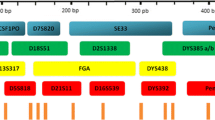Abstract
The Multiplex Ligation-dependent Probe Amplification assay (MLPA) is the method of choice for the initial mutation screen in the analysis of a large number of genes where partial or total gene deletion is part of the mutation spectrum. Although MLPA dosage probes are usually designed to bind to normal DNA sequence to identify dosage imbalance, point mutation-specific MLPA probes can also be made. Using the dystrophin gene as a model, we have designed two MLPA probe multiplexes that are specific to a number of commonly listed point mutations in the Leiden dystrophin point mutation database (http://www.dmd.nl). The point mutation probes are designed to work simultaneously with two widely used dystrophin MLPA multiplexes, allowing both full dosage analysis and partial point mutation analysis in a single test. This approach may be adapted for other syndromes with well defined common point mutations or polymorphisms.
Similar content being viewed by others
References
Schouten, J. P., McElgunn, C. J., Waaijer, R., Zwijnenburg, D., Diepvens, F., and Pals, G. (2002) Relative quantification of 40 nucleic acid sequences by multiplex ligation-dependent probe amplification. Nuc. Acid Res. 30, e57.
Bunyan D. J., Eccles, D. M., Sillibourne, J., et al. (2004) Dosage analysis of cancer predisposition genes by multiplex ligation-dependent probe amplification. Br. J. Cancer 91(6), 1155–1159.
Hoffman, E. P., Brown, R. H., and Kunkel, L. M. (1987) Dystrophin: the protein product of the Duchenne muscular dystrophy locus. Cell 51, 919–928.
Emery, A. E. H. (1991) Population frequencies of inherited neuromuscular diseases—a world survey. Neuromuscular Disord. 1, 19–29.
Beggs, A. H., Koenig, M., Boyce, F. M., and Kunkel, L. M. (1990) Detection of 98% of DMD/BMD gene deletions by polymerase chain reaction. Hum. Genet. 86, 45–48.
Abbs, S., Yau, S. C., Clark, S., Mathew, C. G., and Bobrow, M. (1991) A convenient multiplex PCR system for the detection of dystrophin gene deletions: a comparative analysis with cDNA hybridization shows mistypings by both methods. J. Med. Genet. 28, 304–311.
Lalic, T., Vossen, R. H., Coffa, J., et al. (2005) Deletion and duplication screening in the DMD gene using MLPA. Eur. J. Hum. Genet 13(11), 1231–1234.
Author information
Authors and Affiliations
Corresponding author
Rights and permissions
About this article
Cite this article
Bunyan, D.J., Skinner, A.C., Ashton, E.J. et al. Simultaneous MLPA-based multiplex point mutation and deletion analysis of the Dystrophin gene. Mol Biotechnol 35, 135–140 (2007). https://doi.org/10.1007/BF02686108
Issue Date:
DOI: https://doi.org/10.1007/BF02686108




